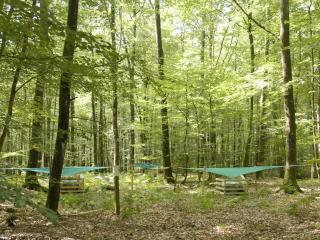Quantitative and Evolutionary Ecology of Communities Group
Members

Doctorante
UCBL

Professeure des universités
VetAgro-Sup
Tel: 33 04 72 43 27 56

Directeur de recherche
CNRS
Tel: 33 04 72 43 27 57

Doctorant
UCBL
Tel: 04 72 44 81 42

Doctorant
CNRS
Tel: 04 72 44 81 42
Doctorant
VetAgro-Sup

Maître de conférences
UCBL
Tel: 04 72 44 81 42
Doctorant
UCBL


Professeur des universités
UCBL
Tel: 33 04 72 43 27 56

Professeur des universités
UCBL

Directeur de recherche
CNRS
Tel: 33 04 72 43 27 56

Maîtresse de conférences
UCBL
Tel: 33 04 72 43 29 02
Maître de conférences
UCBL
Tel: 33 04 72 43 29 02

Our research activities, focused on interspecific interactions (community ecology), aim to better understand the ecological and evolutionary processes structuring species assemblages and biodiversity at different temporal and spatial scales. Our team addresses these major issues using contrasting biological models (communities of large African mammals, insects, microbiota, plants) from 3 complementary angles:
- Our work is strongly anchored in the conceptual framework of evolutionary biology by studying (i) the diversity of adaptive responses implemented by organisms to selective pressures in their environment, (ii) their consequences on population demography and ultimately (iii) the dynamics and composition of species communities.
- Our research is closely linked to societal issues of biodiversity conservation and management by integrating both the functioning of socio-ecological systems and the context of climate change. We conduct experimental studies, manage and ensure the long-term monitoring of several community observation networks.
- Methodological issues also occupy a central place in our team, with the development of new tools for statistical processing and modeling of ecological data. This activity leads to the development of methods and software that we develop and distribute freely.
Research programs

Functioning of African savanna communities
The Hwange LTSER (Long-Term Socio-Ecological Research site in Zimbabwe hosts a long-term interdisciplinary research program that focuses on the functioning of plant and animal communities within the Hwange National Park and the interactions between this protected area and humans living in its periphery. Based on this program, three axes are developed: (1) studying the population dynamics of elephants, exploring their impact and that of management policies on the socio-ecosystem functioning; (2) Understanding the extent to which interactions within and between trophic levels are sensitive to management actions (e.g. sport hunting, water management) and climate change; (3) Decoding human ecology and human-wildlife coexistence mechanisms towards integrated conservation and sustainable functioning of the socio-ecosystem. This research is complemented by more recent works in the Hluhluwe-iMfolozi Park and in the Madikwe reserve in South Africa, which focus on the role of environmental conditions on the hunting success of large African carnivores. We work in close collaboration with the IRL (International Research Lab) Rehabs.
Involved group members : Alice Bernard, Laura Lacomme, Aïssa Morin, Lisa Nicvert, Elie Pedarros, Yolan Richard, Marion Valeix*

Masting and the community dynamics of seed consumers
Masting is a reproductive strategy often encountered in perennial plants, characterized by fructifications highly fluctuating in time and being synchronized at the population level. The seeds produced that way constitute a pulsed resource with a strong impact on the eco-evolutionary dynamics of seed-consuming communities and forest regeneration. Our lack of knowledge of this system still impedes our understanding of the dynamics of temperate forest ecosystems and its future in the context of climate change. Our work carried out on oak forests aims to better understand (i) the proximal causes of masting, (ii) the mechanisms underlying the coexistence of species competing for such highly fluctuating resource and (iii) the co-evolution of consumer exploitation strategies for the fluctuating resource and forest tree fruiting strategies. On the basis of the results obtained, scenarii will be proposed on the future of forest regeneration under climate change, that may serve forest management.
Involved group members : Marie-Claude Bel-Venner*, Emilie Fleurot, Léa Keurinck, Jean Lobry, Samuel Venner

The spread of antibiotic resistance genes in bacteria
Antibiotic resistance is recognized as one of the greatest current threats to human health, and the mobile genetic elements (MGEs) that circulate in bacterial populations and communities are the main vehicles. To understand the dynamics and diversity of MGEs in bacterial pangenomes and the emergence of antibiotic resistance genes, we propose to go beyond the framework of conventional genomics by considering pangenomes as complex ecological communities. In the Ab-One program, we mobilize the concepts and tools developed in community ecology based on an integrative approach (monitoring of bacterial populations/communities evolving in contrasting environments -One-Health approaches-, pan-genomic analyses, experimentation in molecular and cellular microbiology, mathematical modelling). This program is currently focused on the dynamics of MGEs in Acinetobacter baumannii, an antibiotic-resistant microorganism classified as a priority by the WHO. Other more general approaches will illustrate the relevance of this new conceptual framework to understand the dynamics and diversity of MGEs in bacterial pangenomes. This program, co-piloted by our team and a team from CIRI (Horigene) involves the participation of 9 organizations (6 from Lyon -LBBE, CIRI, MMSB, HCL, LEM, VetAgro Sup-, Institut Pasteur (Paris), LMGM (Toulouse ), Robert Koch Institute (Germany)).
Involved group members : Stéphane Dray, Rémi Tuffet, Samuel Venner*

Statistical analysis of ecological data
Understanding the structure and dynamics of species assemblages, and the processes behind them, requires collecting data that are becoming increasingly complex owing to the sophisticated technological developments made available for their acquisition (e.g. GPS, loggers, satellite imagery, molecular data). We are developing new methods for analysing such data, that provide new insights into the ecological processes at work in communities. Multivariate analysis methods allow the analysis of spatial structures, accounting for various information on species (functional traits, morphology, phylogeny), the spatio-temporal variation of species-environment relationships or the multifaceted perception of the protected human-environment relationship. We also model multi-'omics' dose-response data within communities in order to better understand the Adverse Outcome Pathway (AOP) and to better appreciate the risks to the environment. These methodological innovations are made available to the scientific community through the development, distribution and maintenance of software (libraries for the R language: ade4, adegraphics, adephylo, ade4TkGUI, nlstools, fitdistrplus, DRomics, seqinr).
Involved group members: Marie Laure Delignette-Muller, Stéphane Dray*, Jean Lobry, Jean Thioulouse.
Publications
Display of 241 to 270 publications on 656 in total
Studying community assembly using the trait-based null model approach: synthesis and main results on grassland communities
Functional Ecology and Environment .
Poster
see the publicationFunctional Rarity: The Ecology of Outliers
Trends in Ecology & Evolution . 32 ( 5 ) : 356-367
Journal article
see the publicationMowing influences community-level variation in resource-use strategies and flowering phenology along an ecological succession on Mediterranean road slopes
Applied Vegetation Science . 20 ( 3 ) : 376 - 387
DOI: 10.1111/avsc.12311
Journal article
see the publicationHow to design trait-based analyses of community assembly mechanisms: insights and guidelines from a literature review
Perspectives in Plant Ecology, Evolution and Systematics . 25 : 29-44
Journal article
see the publicationDynamics of tree diversity in undisturbed Evergreen forest at Uppangala, Central Western Ghats
Paper presented at the Fourth Indian Biodiversity Congress (IBC 2017) . : 293
Conference paper
see the publicationWood and leaf strategies in a low-elevation rainforest of Western Ghats
Paper presented at the Fourth Indian Biodiversity Congress (IBC 2017), 10-12 March 2017, Pondicherry University, Puducherry, India . : p. 38
Conference paper
see the publicationSensitivity of community-level trait-environment relationships to data representativeness: a test for functional biogeography
Global Ecology and Biogeography . 26 ( 6 ) : 729 - 739
DOI: 10.1111/geb.12573
Journal article
see the publicationfunrar: An R package to characterize functional rarity
Diversity and Distributions . 23 ( 12 ) : 1365 - 1371
DOI: 10.1111/ddi.12629
Journal article
see the publicationTwo disjunct Pleistocene populations and anisotropic postglacial expansion shaped the current genetic structure of the relict plant Amborella trichopoda
PLoS ONE . 12 ( 8 ) : e0183412
Journal article
see the publicationPlant community structure and nitrogen inputs modulate the climate signal on leaf traits
Global Ecology and Biogeography . 26 ( 10 ) : 1138-1152
DOI: 10.1111/geb.12623
Journal article
see the publicationNew insights from niche theory on plant adaptation and ecosystem functioning
Thesis
see the publicationEnseigner les recueil des données : explorer la variabilité biologique ... au chaud, dans une salle de cours
Statistique et Enseignement . 8 ( 2 ) : 79-85
Journal article
see the publicationManagement of the mycorrhizal soil infectivity with Crotalaria ochroleuca, an indigenous wild legume in the tropics: Impacts on microbial functional diversity involved in phosphorus mobilization processes in a sahelian soil
Ecological Engineering . 101 : 130-136
Journal article
see the publicationIncreasing Spring temperature favors oak seed production in temperate areas
EGU General Assembly 2017 . 19 : np
Poster
see the publicationRaisonner l'utilisation des légumineuses ligneuses pour réhabiliter des sols dégradés en milieu méditerranéen et tropical
Innovations Agronomiques . 60 : 125-131
Journal article
see the publicationResponse to Comment on "Robust Fit of Toxicokinetic-Toxicodynamic Models Using Prior Knowledge Contained in the Design of Survival Toxicity Tests
Environmental Science and Technology . 51 : 8202-8203
Journal article
see the publicationRobust Fit of Toxicokinetic-Toxicodynamic Models Using Prior Knowledge Contained in the Design of Survival Toxicity Tests
Environmental Science and Technology . 51 : 4038-4045
Journal article
see the publicationadegraphics: An S4 Lattice-Based Package for the Representation of Multivariate Data
The R Journal . 9 ( 2 ) : 198-212
DOI: 10.32614/RJ-2017-042
Journal article
see the publicationA critical issue in model-based inference for studying trait-based community assembly and a solution
PeerJ . 5 : e2885
DOI: 10.7717/peerj.2885
Journal article
see the publicationEcological networks to unravel the routes to horizontal transposon transfers
PLoS Biology . 15 ( 2 ) : np
Journal article
see the publicationIncreasing spring temperatures favor oak seed production in temperate areas
Scientific Reports . 7 ( 1 ) : 1-8
Journal article
see the publicationThe use of STATICO and COSTATIS, two exploratory three-ways analysis methods: an application to the ecology of aquatic heteroptera in the Medjerda watershed (Tunisia)
Environmental and Ecological Statistics . 24 ( 2 ) : 269 - 295
Journal article
see the publicationFlowering overlap in Mediterranean plant communities along an ecological succession with recurrent mowing - Synchrony predominates at earlier stages and under mowing
Sfécologie-2016; International Conference of Ecological Sciences .
Poster
see the publicationFrom the neutral theory to a comprehensive and multiscale theory of ecological equivalence
Quarterly Review of Biology . 91 ( 3 ) : 321-342
DOI: 10.1086/688098
Journal article
see the publicationInfluence of past and present environmental heterogeneity on the ecology and biogeography of Western Ghats endemic tree species
53th Annual meeting of the Association for Tropical Biology and Conservation (ATBC) - Tropical Ecology and Society Reconciliating Conservation and Sustainable Use of Biodiversity . : 227
Conference paper
see the publicationSalar de Uyuni (Bolivia): fragile biodiversity challenged by tourism and agriculture expansion
53th Annual meeting of the Association for Tropical Biology and Conservation (ATBC) .
Poster
see the publicationWhat it takes to invade grassland ecosystems: traits, introduction history and filtering processes
Ecology Letters . 19 ( 3 ) : 219 - 229
DOI: 10.1111/ele.12556
Journal article
see the publicationPast potential habitats shed light on the biogeography of endemic tree species of the Western Ghats biodiversity hotspot, South India
Journal of Biogeography . 43 ( 5 ) : 899 - 910
DOI: 10.1111/jbi.12682
Journal article
see the publicationUsing the past to predict the future: the case of French Mediterranean orchids
The Mediterranean region under climate change: a scientific update . 978-2-7099-2219-7 : 377-386
Book chapter
see the publicationThe DISCO-WEED project : disentangling the role of anthropic DISturbances and eCOlogical processes on WEED community assembly
Sfécologie-2016, International Conference of Ecological Sciences . : np
Poster
see the publication
You also, comment on this article